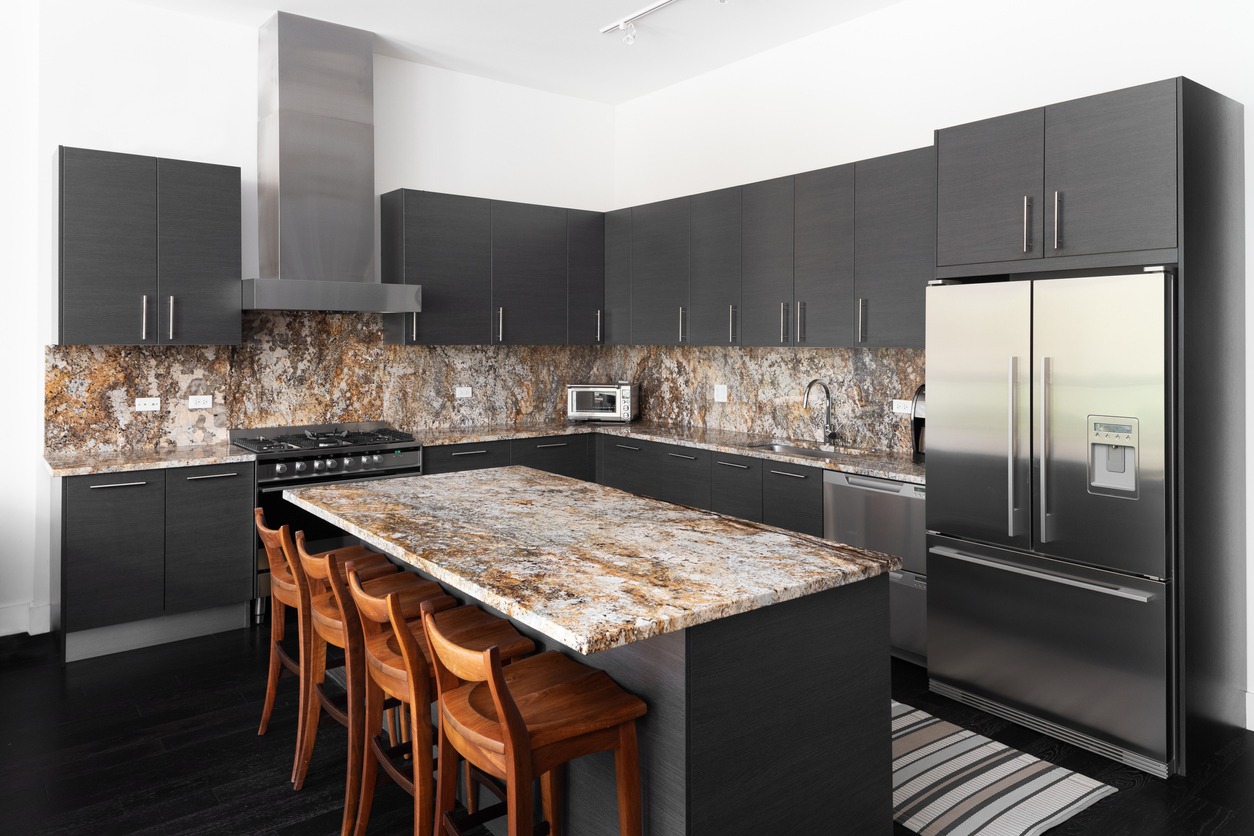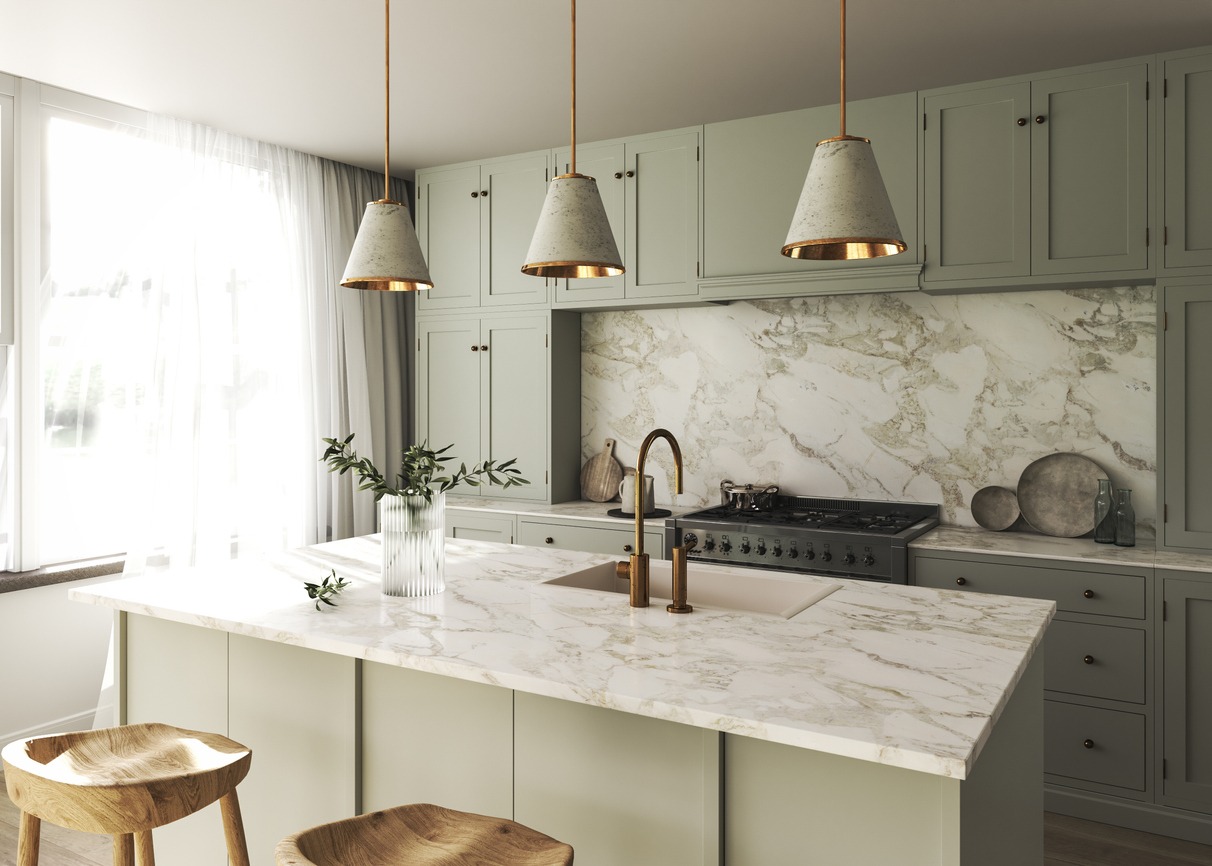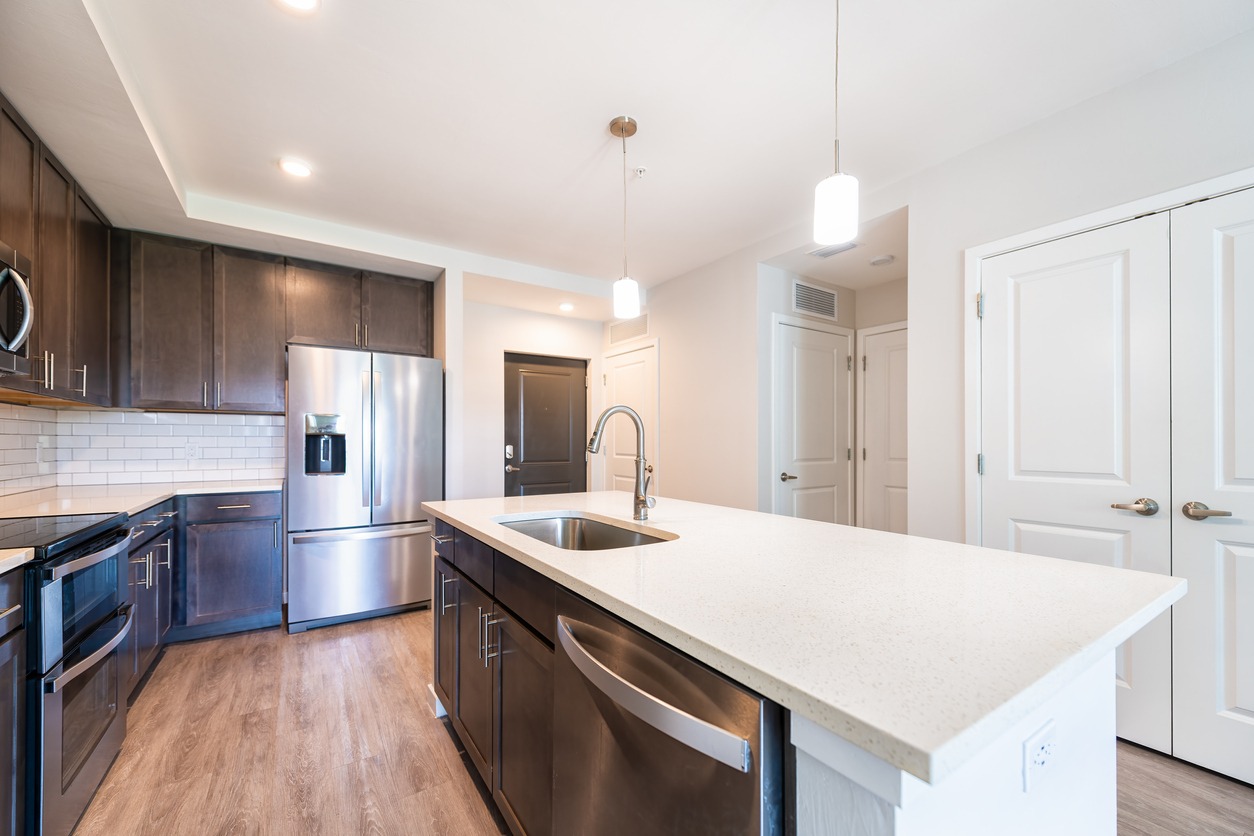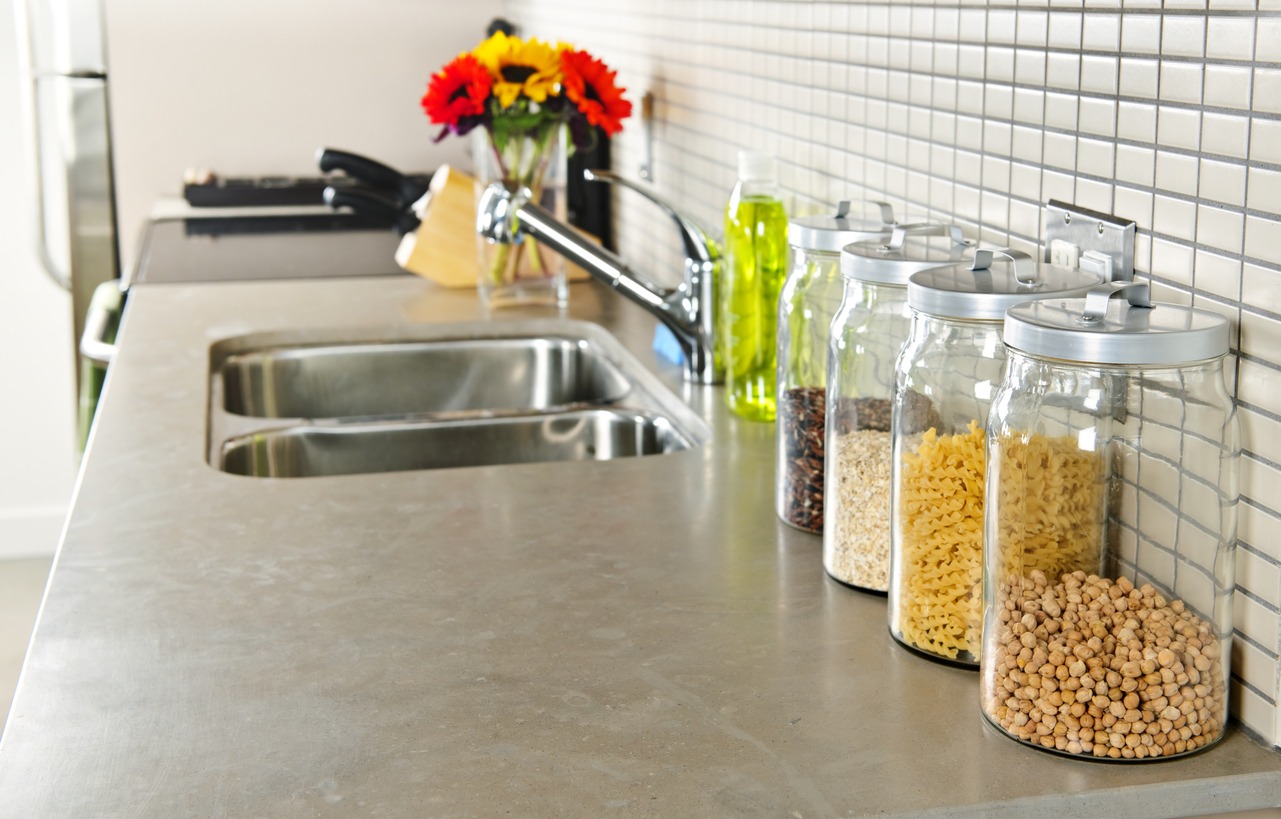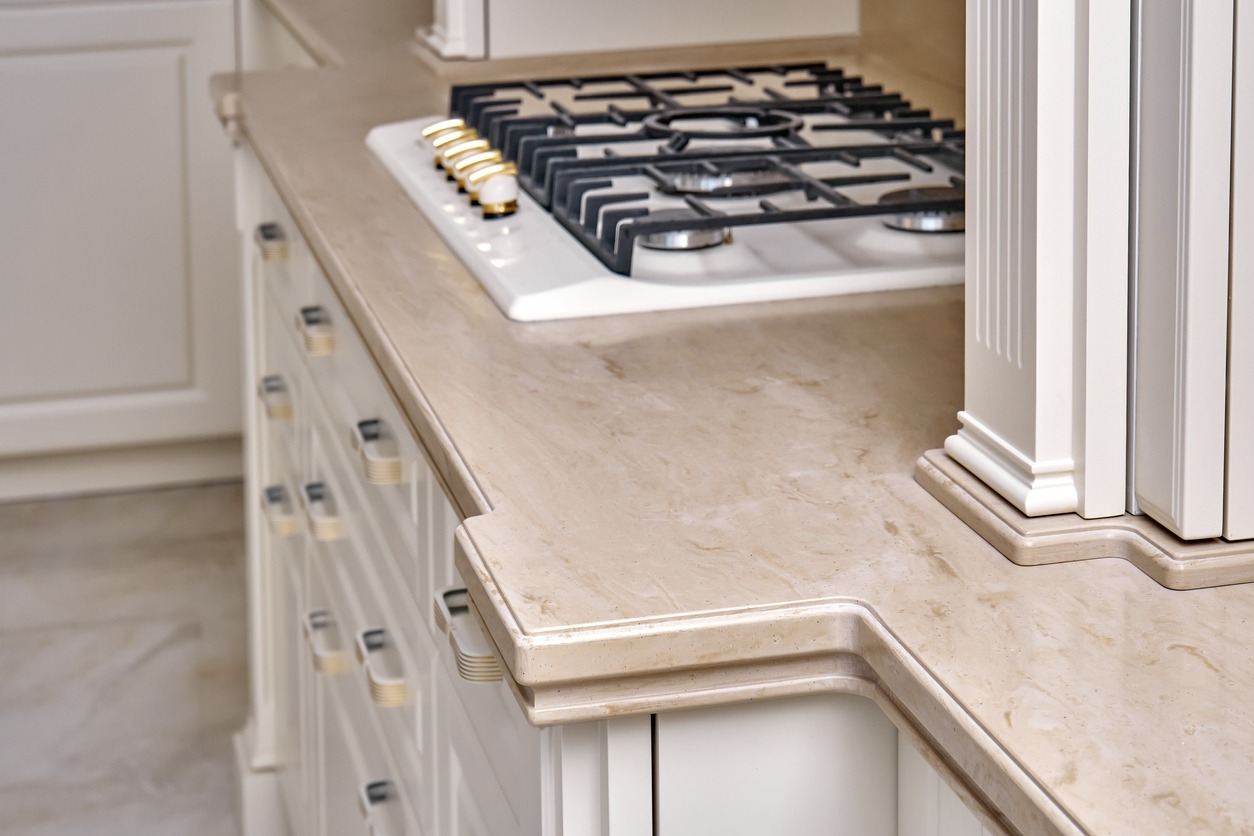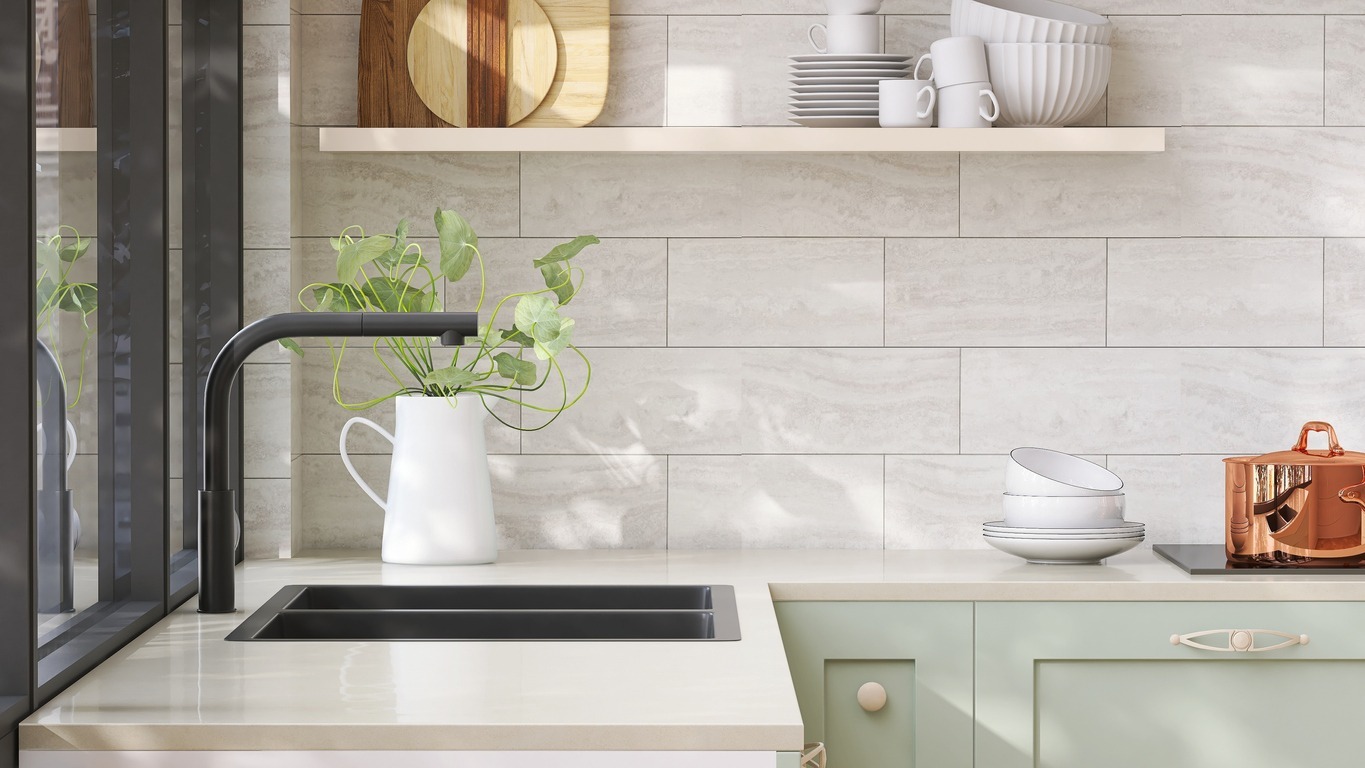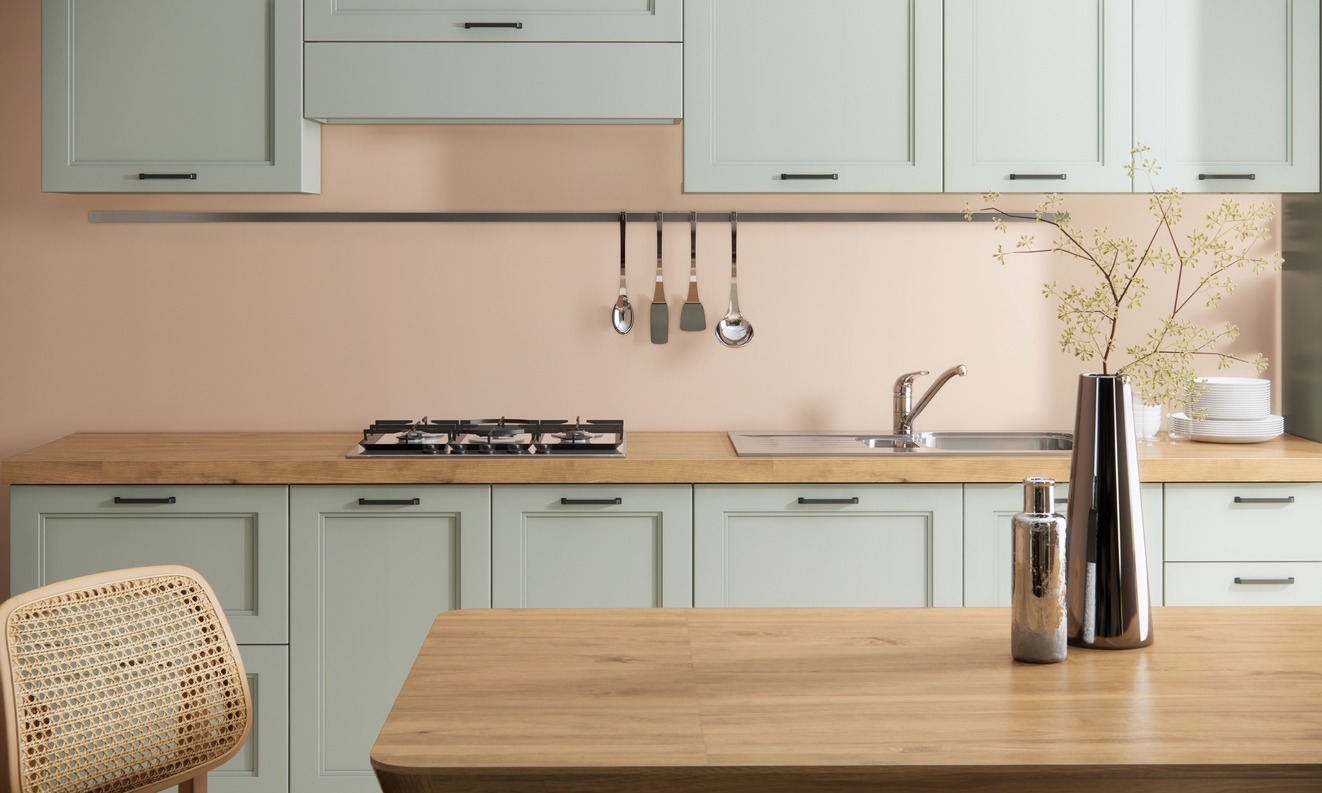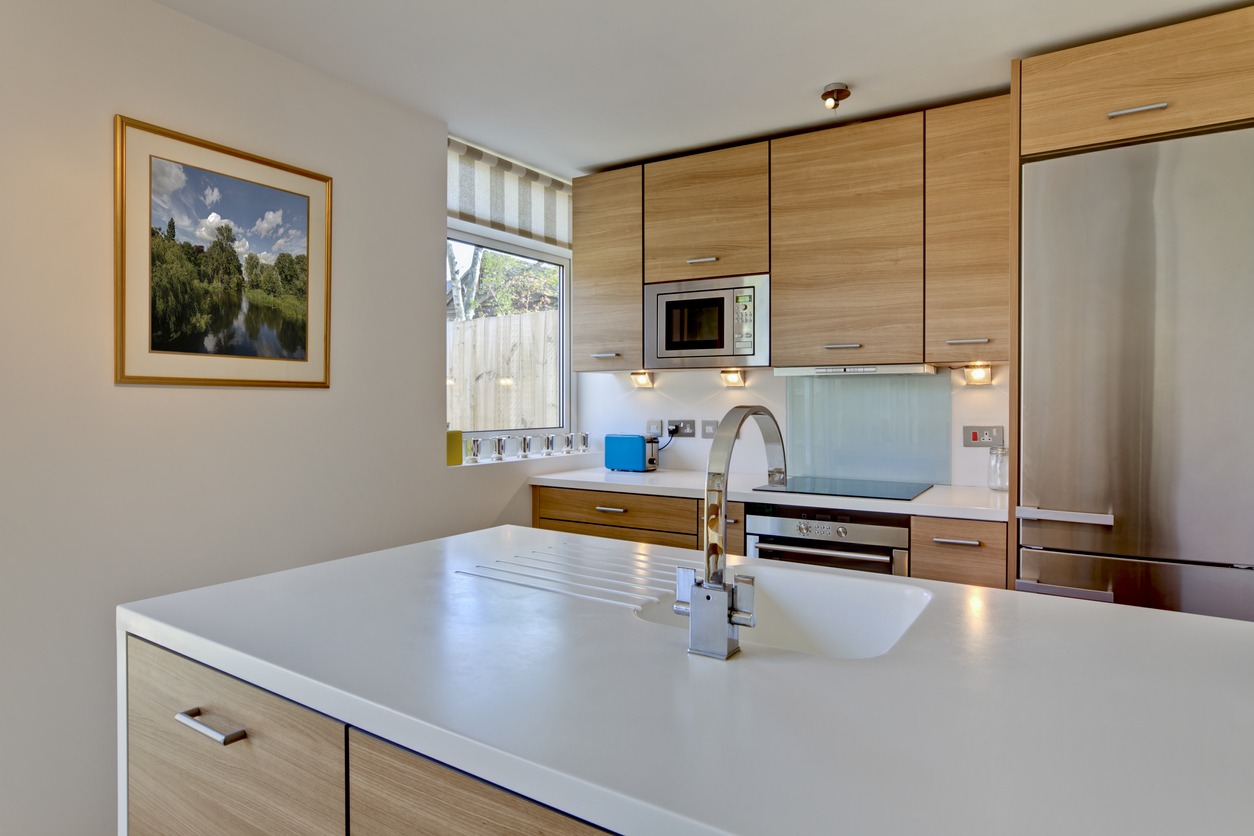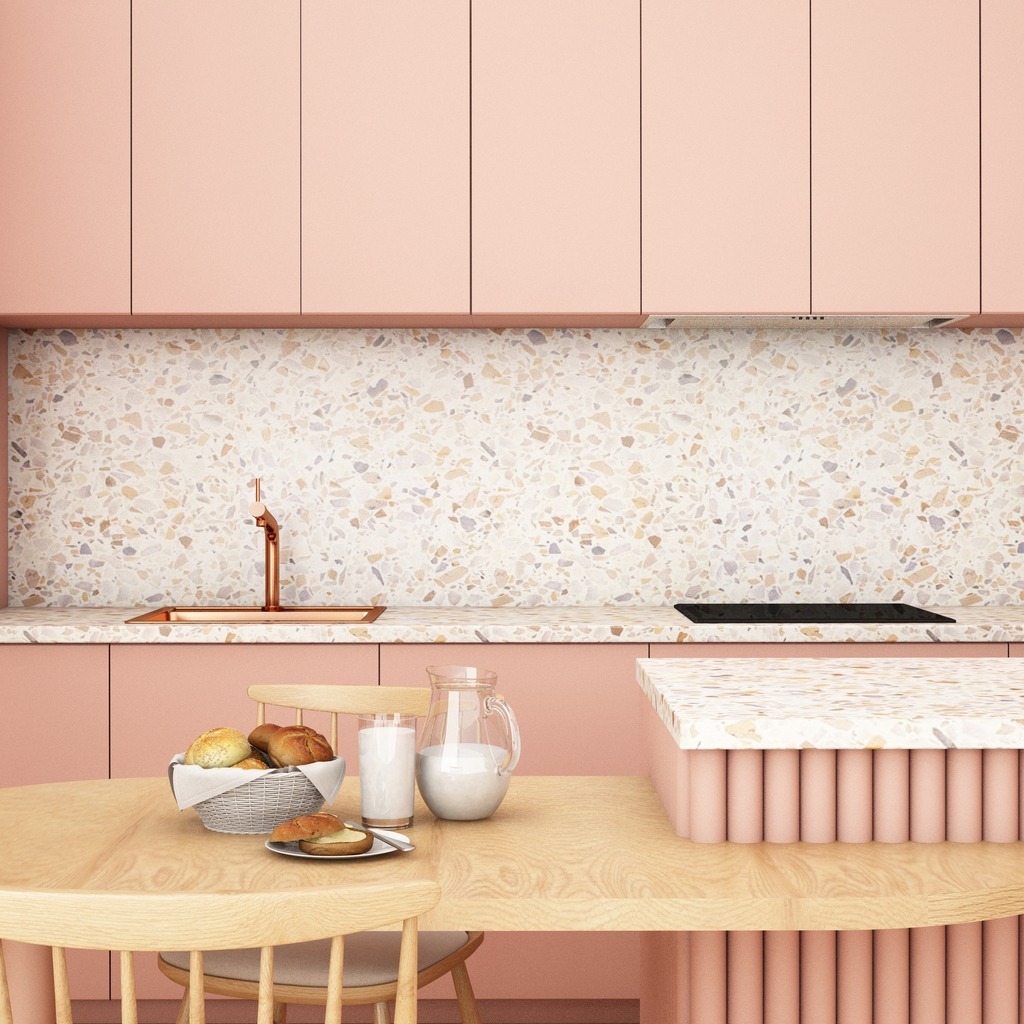When it comes to kitchen countertops, there’s a lot to consider. Each countertop material has its own unique qualities, like durability, appearance, and maintenance needs. No matter your kitchen style – whether it’s traditional, modern farmhouse, or contemporary – we’ve got a list of all the countertop options to consider. This guide breaks down the most common countertop types, helping you weigh the pros and cons to find the perfect fit for your kitchen.
Granite Countertops
Granite countertops have long been a kitchen standard, cherished for their natural beauty and resilience. When it comes to popularity, it shares the spotlight with quartz, so you can easily find a material supplier. These natural stone surfaces can handle impacts and resist heat, making them ideal for culinary spaces. However, it’s not knife-friendly, as it can dull blades due to its hardness. And due to its weight, it’s best to let the pros handle the installation.
Spacious, traditional kitchens that can fully embrace granite’s natural allure. Its natural appeal and uniqueness make it a favorite for many. They come in a diverse array of colors and can be tailored with various styles. The patterns lean towards the dense side, so keep that in mind for your kitchen style.
With proper care, granite can grace your kitchen for decades. Cleaning is easy – it only needs a gentle soap and water. However, because it’s a porous natural stone, you should seal it every few years to prevent staining.
Pros:
- Resistant to heat and wear
- Exceptionally durable
- Wide range of colors and patterns
Cons:
- Higher price point
- Needs regular sealing
- Heavy and pro installation is recommended
Marble Countertops
Marble, a high-end kitchen countertop material, is celebrated for its visual appeal. The natural stone instantly elevates the kitchen, offering a sleek, modern look. It’s particularly known for its bright white finish, although you can find it in various colors, from gray to green. Each marble countertop boasts its own distinctive marble veining or patterns formed by mineral deposits, ensuring a one-of-a-kind design.
Marble is a luxurious material of choice, so it comes with a high price tag, and its installation is best left to experienced professionals. Surprisingly, some types of marble, like Carrara, can be budget-friendly despite their upscale appearance.
Marble also maintains a naturally cool temperature, making it ideal for baking enthusiasts who enjoy working with dough. However, it’s susceptible to scratches and stains, which necessitates annual sealing to maintain its pristine condition.
While marble’s beauty is undeniable, it comes with practical considerations. It’s softer than other natural stones, so using cutting boards is a must to prevent scratching. Being porous, it’s vulnerable to stains, so swift cleanup of spills like red wine and lemon juice is essential. Fortunately, advancements in sealants are making it more stain-resistant.
Pros:
- Heat-resistant, crack-resistant, and durable
- Aesthetic appeal with unique marble patterns
- Long-lasting material
Cons:
- Prone to scratches and staining
- Requires regular sealing and upkeep
- Higher price tag
Quartz Countertops
Quartz, often known as engineered stone, provides an excellent alternative to the natural appeal of marble or granite without breaking the bank. Comprising around 90 percent quartz particles mixed with other minerals, it forms a robust, stain-resistant countertop. It’s non-porous, ultra-tough, and never requires re-sealing.
While it’s more affordable than real marble, it’s still an investment. Crafted from natural stone powder, synthetic resins, and pigments, it undergoes high-temperature and high-pressure treatment to achieve its natural stone-like appearance.
Buyers and sellers alike are increasingly drawn to quartz thanks to its reliability. You get the look of marble or granite without concerns about wear and tear. It comes in a vast array of colors and patterns to suit your kitchen style.
Since it’s non-porous, quartz won’t soak up stains. Cleaning is easy, and it’s resistant to mold, mildew, and bacteria, making it perfect for food prep areas. However, it’s essential to avoid exposing it to hot objects, as it can suffer heat damage and even melt. Plus, be mindful of direct sunlight, as it can cause color fading.
Pros:
- Low maintenance, no need for sealing
- Resistant to mold, mildew, and stains
- Wide range of color choices
Cons:
- Vulnerable to heat damage
- Prone to scratches
- Color can fade in direct sunlight
Soapstone Countertops
Soapstone, sourced domestically from the Appalachian Mountains or internationally from places like Finland and Brazil, boasts a high talc content, resulting in its soft, soap-like texture. This naturally occurring stone is entirely non-porous, which means it resists stains effectively.
Compared to marble and granite, it offers several advantages. It demands minimal upkeep, is entirely non-porous, and resists stains, bacteria, and heat. Its unique appearance, available in various gray shades with intriguing undertones, adds character to any kitchen. The natural veining patterns vary from stone to stone. However, soapstone can be vulnerable to scratches and dents.
What’s unique about soapstone is that any minor wear and tear can enhance its charm over time, developing a distinctive patina as the surface oxidizes. You can select from a range of gray shades with hints of blue or green undertones featuring marble-like veining.
To maintain your soapstone kitchen countertops and foster that captivating patina, it’s advisable to apply mineral oil roughly once a month during the first year after installation.
Pros:
- Distinctive veining and color variations
- Non-porous, heat-resistant, and stain-resistant
- Natural patina development for antique charm
Cons:
- Patina takes time to develop
- Requires periodic mineral oil treatment
- Prone to surface scratches and abrasions
Solid Surface Countertops
Solid surface material is a versatile choice for kitchen countertops, composed of acrylic particles and resins crafted into sheets. Originally designed to emulate natural stone, it offers an attractive middle-ground option.
One major advantage of solid-surface material is its cost-effectiveness compared to natural stone. It’s available in a wide array of colors, patterns, and styles, including convincing imitations of granite and marble.
The virtually invisible seams and resistance to stains ensure that your countertop will maintain its pristine appearance for years. However, it’s important to note that solid-surface material is not heat-resistant, so avoid placing hot objects directly on it to prevent damage. Additionally, exercise caution to prevent scratches and dents.
Pros:
- Stain-resistant
- Nearly invisible seams
- Diverse color and pattern options
Cons:
- Moderately priced
- Vulnerable to heat damage
- Prone to scratches and dents
Ceramic Tile Countertops
Tile countertops had their heyday in the 70s and 80s but are making a comeback, especially for budget-conscious DIYers. Tiles are available in various sizes, shapes, and materials, from classic squares to trendy hexagons, including porcelain, ceramic, and natural stones. Granite, quartz, and marble tiles offer a more budget-friendly alternative to large slabs.
Creating a ceramic tile countertop involves laying individual tiles on a cement-board core using thin-set mortar adhesives. It’s a cost-effective choice that delivers durability and heat resistance. However, the size of each tile can present challenges in terms of food preparation and ease of cleaning.
Ceramic tile countertops come in a wide array of colors, patterns, and styles, allowing you to achieve the desired look for your kitchen. Just remember that ceramic tile is somewhat brittle and prone to cracking. The grout lines, which are part of the tile installation, can be susceptible to staining and may require extra effort to keep clean.
The maintenance and durability of tile depend on the material chosen, but one common challenge with tile countertops is keeping the grout lines clean and looking fresh. If your countertop sees frequent spills and messes, you might consider opting for darker-colored grout like gray or black to minimize staining.
Pros:
- Affordable countertop option
- DIY-friendly installation
- Variety of colors and patterns
Cons:
- Grout lines can stain
- Tile sizes may limit functionality
- Tiles are brittle and susceptible to cracking
Laminate Countertops
Laminate countertops are typically one of the most economical options available. They consist of a particleboard core with a laminated sheet on the exterior, crafted from paper or fabric fibers combined with melamine resin for strength and water resistance. While older laminates had issues with peeling or swelling when wet, modern manufacturing techniques have largely resolved these problems unless the laminate is severely damaged.
One of the advantages of laminate is its versatility in replicating various patterns, such as granite, marble, or wood grain, and it’s available in a wide spectrum of colors. This makes it suitable for modern, retro, or traditional kitchen designs. It’s also a favorite choice for DIY enthusiasts seeking an affordable countertop option that’s relatively easy to install due to its lightweight nature.
Its non-porous surface is a shield against mold, bacteria, and stains, ensuring easy maintenance. While it’s easy to wipe clean, laminate lacks the durability of quartz or natural stone. Avoid placing hot cookware directly on the surface, and always use a cutting board to prevent scratches. Although today’s laminates are quite sturdy, heavy impacts can chip the surface. Fortunately, repair and refinishing products are readily available.
Pros:
- Easy to clean and maintain
- Budget-friendly choice
- Resists mold, mildew, and stains
Cons:
- Vulnerable to heat damage
- Prone to peeling
- Susceptible to scratches and dents
Wood or Butcher Block Countertops
Butcher block countertops derive their name from their initial use as a cutting surface for butchers. The wood blocks excel at absorbing the impact of heavy knives and cleavers, and to some extent, the grain possesses self-healing properties. Various woods, such as oak, maple, and occasionally teak with natural protective oils, are used. These surfaces need regular oiling or sealing to guard against stains. The choice of wood significantly affects the price of butcher block countertops, which can vary widely.
Wood countertops have a rich history in home construction, adorning tables, chairs, and more. These countertops are typically crafted from maple, oak, teak, ash, or even bamboo, offering a spectrum of choices for your kitchen’s style.
While durable, butcher block countertops can accumulate nicks and cuts over time. Sanding out these marks and refinishing the surface is not challenging, although many people embrace small imperfections as part of the material’s character. For budget-conscious individuals, laminate versions mimic the appearance of butcher blocks without the same resilience.
Wood’s fibrous nature makes it susceptible to surface scratches, stains, and even burns. To restore its original appearance, you can sand and re-seal the wood every two to three years or as needed. Regular oiling and sealing can also prevent moisture, mold, mildew, and bacteria from penetrating the fibrous surface.
Pros:
- Durable, long-lasting material
- Environmentally friendly option
- Attractive country-style appearance
Cons:
- Prone to moisture and stains
- Porous material vulnerable to bacteria
- Requires frequent oiling and sealing
Stainless Steel Countertops
Stainless steel has long been hailed as the top choice for countertops in professional kitchens. Its sleek, industrial appearance is a staple in commercial kitchens worldwide, known for its ease of maintaining high levels of hygiene and exceptional durability. As its name suggests, stainless steel truly lives up to its reputation—it’s resistant to mold mildew and a breeze to wipe clean. It stands impervious to heat and liquids. These qualities make stainless steel the preferred countertop for avid home chefs who prefer to focus on culinary excellence rather than kitchen upkeep.
If you’re after a modern kitchen aesthetic and heat resistance, stainless steel is worth considering. However, be ready to contend with frequent water spots and fingerprint marks on its smooth surface. Additionally, keep in mind that stainless steel is susceptible to scratches, dents, and other forms of abrasive damage, so using cutting boards is essential to protect its surface.
Pros:
- Impervious to heat damage
- The easiest material to clean
- Resistant to mold, mildew, and stains
Cons:
- Relatively costly
- Prone to surface scratches
- Prone to displaying fingerprints and water spots
Concrete Countertops
Concrete countertops, popularized by figures like Joanna Gaines, can elevate a farmhouse chic or modern industrial kitchen. Concrete boasts a bold, striking look and remarkable durability, akin to the material used for roads and sidewalks. These countertops are typically custom-cast in your kitchen due to the weight of the material, adding to their unique appeal. However, this custom work does come at a higher cost compared to more common countertop options.
Concrete countertops can be customized with color tints and decorative textures to enhance their appearance and feel. They’re resistant to scratches and heat, but their porous nature makes them susceptible to moisture, bacteria, and stains.
You can opt for commercial concrete countertops or even try a DIY approach with a kit. Keep in mind, though, that concrete can take up to 28 days to fully dry, so it’s not ideal for tight schedules. Sealing is also a requirement.
To maintain concrete countertops, regular sealing is essential. It’s worth noting that any home shifting or excessive tension from over-tightening fixtures like faucets can create stress within the concrete, potentially leading to cracks over time.
Pros:
- Heat resistant
- Scratch resistant
- Unique industrial appearance
Cons:
- Relatively expensive
- Requires high maintenance
- A porous surface necessitates regular sealing
Terrazzo
Terrazzo, although relatively new to kitchen countertops, has its roots in 16th-century Italy, where it was initially used as a flooring material by mosaic workers. It remains popular for flooring today. Terrazzo countertops are crafted from a mix of granite, marble, quartz chips, and sometimes glass or metal fragments, all bound together with cement and resin. The result is a distinct appearance that sets it apart from other materials.
Terrazzo offers several advantages as a kitchen countertop material. It shares the durability of quartz but is often more cost-effective. Its non-porous nature means it’s resistant to staining and highly heat-resistant. It’s tough and UV-resistant, making it suitable for outdoor use.
Moreover, the use of recycled materials and the absence of toxic volatile organic compounds (VOCs) give terrazzo eco-friendly credentials. While its appearance may not suit everyone’s taste, the primary drawback is its susceptibility to cracking if not installed correctly, with repairs being challenging.
Pros:
- Durable, non-porous, and heat-resistant
- Cost-effective
- Suitable for outdoor kitchens
Cons:
- Gives a retro appearance that not everyone will like
- Susceptible to cracking
- Challenging to repair
FAQs
1. What is the most popular choice for a countertop material?
Quartz and granite are among the top choices for countertops. Quartz doesn’t require sealing and has inconspicuous seams. Granite, a long-standing favorite, offers durability, a luxurious appearance, and increased home value. Both options are relatively costly, but quartz, being engineered stone, requires more craftsmanship and comes at a higher price.
2. Which countertop is the easiest to maintain?
Laminate, quartz, and stainless steel countertops are some of the easiest to maintain. Quartz can endure hot pots, sharp utensils, and spills without additional care or sealing. Stainless steel never needs sealing, cleans easily with mild soap, and resists staining. These materials are also heat-resistant. Laminate, while non-porous and maintenance-free, can chip over time, but it’s the most budget-friendly for replacement.
3. What is the most affordable countertop?
Laminate countertops are the most budget-friendly option. They can be customized with features like end caps, mitered corners, or rounded edges and even mimic the appearance of granite, marble, or butcher block. While lightweight and easy to install, laminate can be susceptible to scratches, burns, stains, chips, or peeling.


